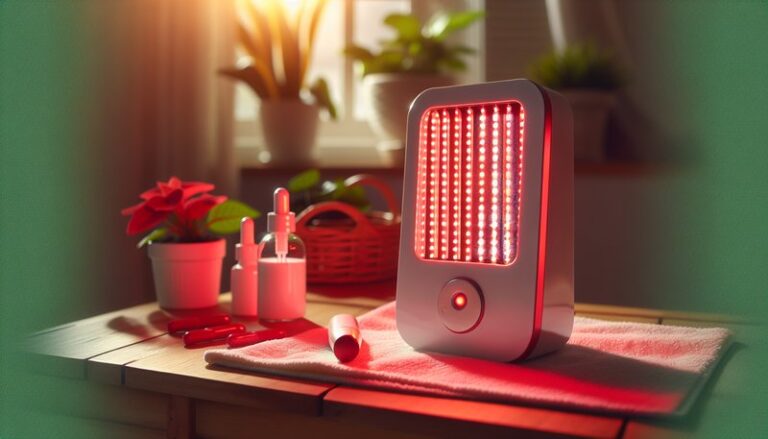Is Infrared Sauna Red Light Therapy?
Is Infrared Sauna Red Light Therapy?
Is an infrared sauna simply another form of red light therapy? This question has sparked interest among wellness enthusiasts and health practitioners alike.
Discover the in-depth guide Does Red Light Therapy Reduce Facial Fat?
This article aims to distinguish between infrared saunas and red light therapy, explore their respective benefits, and consider their similarities and differences. By the end, you’ll have a clear understanding of whether these two treatments are interchangeable or serve unique purposes in the realm of health and wellness.
Key Takeaways
- Infrared saunas and red light therapy utilize different technologies to promote health benefits.
- Both therapies may improve skin health, enhance relaxation, and support muscle recovery.
- Understanding the distinctions will help you choose the right therapy for your specific needs.
What is Infrared Sauna and Red Light Therapy?
An infrared sauna is a type of sauna that uses infrared light to heat the body directly, rather than warming the air around it. This allows for a deeper penetration of heat, which is thought to promote relaxation and detoxification.
Red light therapy, on the other hand, is a treatment that uses specific wavelengths of red light to stimulate cellular function and repair in the body. It is often utilized for skin healing, pain relief, and inflammation reduction.
While both methods utilize light, they operate on different principles and mechanisms within the body.
Infrared Sauna Explained
Infrared saunas make use of infrared heaters that emit light in the infrared spectrum. This light can penetrate the skin and raise the core body temperature. Users typically experience benefits such as increased circulation, improved muscle recovery, and relaxation.
Red Light Therapy Explained
Red light therapy involves the application of low-level red wavelengths of light to the skin. This therapy is known to support cellular energy production (ATP), enhance collagen production, and reduce inflammation. It is commonly used for skin rejuvenation, wound healing, and pain relief.
What are the Benefits of Infrared Sauna and Red Light Therapy?
Both infrared saunas and red light therapy offer a range of potential health benefits, which makes understanding them vital for anyone considering these treatments.
Benefit 1: Improved Skin Health
Infrared saunas can help in detoxifying the skin and enhancing its appearance through sweating. Meanwhile, red light therapy stimulates collagen production, which can reduce signs of aging and improve skin elasticity.
Benefit 2: Enhanced Relaxation and Stress Relief
Both therapies promote relaxation. Infrared saunas help lower stress levels through heat exposure, while red light therapy can positively impact mood by influencing certain hormonal levels.
Benefit 3: Muscle Recovery and Pain Relief
Infrared saunas can aid muscle recovery post-exercise, while red light therapy has been shown to reduce pain from injuries and inflammation, promoting faster healing.
Additional Benefits
- Supports cardiovascular health through improved circulation in both therapies.
- May aid sleep quality due to relaxation effects.
- Potential reduction in joint pain for those with chronic conditions.
Is it Possible to Use Infrared Sauna for Red Light Therapy?
While many people enjoy the benefits of both infrared saunas and red light therapy, they are not typically used interchangeably. Infrared saunas focus on heat therapy while red light therapy concentrates on stimulating cellular repair and healing through specific light wavelengths.
What are the Advantages of Using Infrared Saunas?
- Deep tissue penetration for warmth and relaxation.
- Increased metabolic rate and calorie burning during sessions.
- Detoxification through sweating.
What are the Disadvantages of Using Infrared Saunas?
- Not suitable for everyone, especially those with heat intolerance or certain medical conditions.
- Can lead to dehydration if proper hydration is not maintained.
- Initial investment for a home sauna can be considerable.
What are the Things to Consider Before Choosing Between Infrared Saunas and Red Light Therapy?
It’s essential to consider personal health goals, comfort levels, and available resources when choosing between these therapies.
Consideration 1: Personal Health Goals
Determine if your primary objective is to detoxify, relax, or treat a specific condition requiring light therapy.
Discover the details in Is red light therapy insured?
Consideration 2: Health Status
Consider existing health issues that may make one therapy more suitable than the other. Consulting a healthcare provider can be beneficial.
Consideration 3: Budget and Accessibility
Evaluate how much you’re willing to invest in either therapy and your access to facilities that offer them.
Additional Considerations
- Check the safety of the devices being used.
- Think about maintenance and operating costs if considering an at-home option.
- Time commitment required for each therapy.
What are the Alternatives to Infrared Saunas and Red Light Therapy?
If you’re exploring wellness therapies, you might consider several alternatives that offer similar benefits.
Alternative 1: Traditional Saunas
Traditional saunas utilize steam or dry heat to induce sweating and relaxation, making them a viable alternative for detox and stress relief.
Alternative 2: Cold Therapy
Cold exposure therapies, such as cryotherapy, provide anti-inflammatory benefits and can be great for recovery but work on a different principle than heat.
Alternative 3: Massage Therapy
Massage offers relaxation and muscle recovery, complemented by the benefits of touch, which can be particularly appealing for stress reduction.
Additional Alternatives
- Yoga and meditation for relaxation and mental clarity.
- Acupuncture as a means to promote healing and wellness.
- Physical exercise for endorphin release and overall health benefits.
Conclusion: Is it Recommended to Opt for Infrared Sauna or Red Light Therapy?
Both infrared saunas and red light therapy provide unique health benefits and can complement each other in a holistic wellness routine. Ultimately, the choice between them should depend on your personal health goals, existing medical condition, and preferences.
In conclusion, while they share some benefits, infrared saunas and red light therapy are distinct modalities that serve different purposes. Consulting with a healthcare professional can offer personalized advice based on individual needs.
Frequently Asked Questions
Is infrared sauna safe for everyone?
Most people can safely use infrared saunas, but those with certain health conditions, like cardiovascular issues or heat sensitivity, should consult a healthcare provider before using them.
How long should I use an infrared sauna?
Sessions typically last 20 to 45 minutes, but it’s important to listen to your body and stay hydrated during and after use.
Can I use red light therapy every day?
Yes, many users find daily sessions beneficial, but it’s best to follow the manufacturer’s guidelines for specific devices.
Are there any side effects associated with red light therapy?
Red light therapy is generally considered safe, but potential side effects may include mild skin irritation or headaches in rare cases. Always start with shorter sessions to assess tolerance.
How do I choose between an infrared sauna and red light therapy?
Consider your health goals, budget, and preferences. A consultation with a healthcare provider can help clarify which option is best for your needs.






